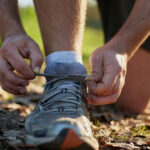An article originally published in The Times by Helen Rumbelow about the amount of time we spend sitting down during the day. It is a tongue in cheek perspective of someone who spends a great part of the day sitting down, but who would like to get out of that habit. Humour aside, it is does highlight some of the difficulties that arise when attempting to break from the norm.
In Scandinavian countries, it is estimated that as many as 90% of office workers have access to sit-stand workstations. In the United Kingdom, that figure is just 1%. Culturally, we are told that concentration and productivity are best achieved when sitting down. New research, however, shows that this may not actually be accurate, and could, in fact, lead to health problems. Standing for prolonged periods of time can also have detrimental effects on health, so it is important to find a balance. This is something that is currently not possible to achieve in most British offices due to poor workstation ergonomics.
I’M A SITTING ADDICT. I NEED TREATMENT
by Helen RumbelowHealth experts say we should stand up more. Is it really healthy, asks Helen Rumbelow
Hello. My name is Helen and I am a sitting addict. I do it whenever I can. With friends, who encourage me (“have a nice sit down” they say, like a bunch of junkies); at my work, which, like most British offices, is sitaholics HQ.
We sit our way to an early death and we don’t seem to care. We are literally bad asses. Sitting is the new smoking, say the experts, and I am on the equivalent of two packs a day: an eight hour a day girl whose pins and needles thighs are merging into the upholstery.
Yet, with the latest recommendation from Public Health England, to break up a sitting day with four hours of standing, comes new problems. An entire industry supports those who want to give up smoking. For anyone, who, like me, wants to quit the sitting habit, you’re on your own. Not only on your own, but conspicuously on your own, the lone stander at your office, like a Meerkat at a urinal.
The science is new. How much sitting is too much? Confusingly, research shows that too much standing is also detrimental, as any hairdresser will tell you. Is it a coincidence that the early-adopters of standing desks are men in the tech industry? I think not; for desk-standing requires two things. First, ugly footwear. I’m even talking Crocs. Second, a lack of self-consciousness. About two years ago, I developed a sitting-related – and nicely symbolic – pain in my arse.
I tried stacking my keyboard on some books and standing. It helped, but I felt like a prat. Would I rather die than be the first at a standing desk? Now, after questioning experts and standing-desk veterans, I have come to some surprising conclusions. Warning: also some discussion of “cankles”.
First, you shouldn’t stand all day. I asked Hidde van der Ploeg, a sitting researcher from the VU University Amsterdam, whether the old wives’ tales about standing are right.
“Absolutely”, he said. “Standing for eight hours a day is not a good idea. We know it increases varicose veins and can be a problem for your neck and back. Moving is better than standing, but it’s not so feasible. So we’re aiming for a nice balance of sitting, standing, and moving around.”
Don’t stand cold turkey, Nicola Cairncross, founder of a digital marketing agency, rigged up her own standing desk two years ago.
“I don’t stand for that long, maybe one to four hours a day,” she says. “I have in mind that my dad died of thrombosis, due to standing up all the time. He drive ships the merchant navy, at the wheel for 12 hours a day.”
So too, warns one of the most entertaining writers on the subject, Gwynn Guilford, a New York-based reporter. She chucked her chair, and a few weeks in was free of back pain, but “I noticed bulbs of pinkish flesh ballooning out over my shoes… Cankles in other words.”
I caught up with Guilford (who emailed me, while standing), and asked after cankles. She warns: “Do not stand all day. That was very dumb of me. Cankle-avoidance is much easier now that I’ve create a sit-stand routine. I also drink lots of water so I trek to the rest room every hour, which keeps me moving. Oh, and exercises are helpful. I feel a little dorky when doing shoulder rolls and calf-raises and marching in place, but what can you do?”
So most people who say they have a standing desk actually have a variable one, and according to the laws of human nature, are sitting more than they think or tell you.
This leads on to the second problem. We are not yet sure if there is a maximum sitting or standing time. I spoke to one of the leading lights of anti-sedentary research, Stuart Biddle, at Melbourne’s Victoria University.
“We don’t know at this stage how much is too much,” says Biddle, who sits for less than four hours a day. “We know we need to sit less, but it’s a guess until more studies more studies come in.”
Van der Ploeg asked office workers to do a 1:2 ratio of standing to sitting. I point out that Public Health England is advocating a 1:1 split, but he says that he had to be realistic.
“If you cut down sitting by a third, that’s a very substantial gain,” he says. “We think that’s more feasible. Treadmill desks are better than standing, but they’re more expensive and harder to type at. Culturally, in most offices, standing is odd. And walking desks are odder still.”
This is again backed up by the research. Humans are genetically lazy, we’re creatures of habit and conformity. In one study, an office provided a bank of standing “hot desks”. Workers tried them briefly but overall sitting remained the same. In another study, two groups of 15 office workers were given variable sit/stand desks. One group was also given in-office “standing” coaches and repeated exhortations from their bosses to stand as much as possible. Those with just the sit/stand desks reduced their sitting by 33 minutes a day. Those who received a management pressure to stand did 89 minutes less sitting.
So, it matters a lot if your boss leads from the front. Still, their times were nothing like the new recommendations. We’re trained from the age of four to sit still to concentrate. Research shows, unsurprisingly, that the university-educated sit the most. Should we pay danger money to those whose jobs demand close focus? I read many on-line struggles of switching to standing desks, including this: “harder to muffle your farts, since no chair is enclosing your buttocks”.
Mikael Cho, the founder of Crew, a digital design agency in Canada, built his first standing desk “feeling like a proud new dad”, as he wrote on his blog. Two weeks later he junked it. He found the effort of standing distracting: “when words are flowing, leg fatigue shouldn’t cut a writing session short.”
But there is a little-talked about third option, suggested by Van der Ploeg. For all this talk of standing offices, his research found that in Australia, 90 percent of adult leisure time was spent sitting down, “and I wouldn’t be surprised if in the UK it was similar”. Socialising, driving, commuting, watching TV, going to the cinema or football matches – it adds up to a lot of bums on seats.
“There is a lot to gain here,” says van der Ploeg. At home he puts his laptop on the breakfast bar. And he is the bloke selfishly giving up his seat on the train home.
Originally published in The Times. Available online (subscription required)
WE CAN HELP YOU…
If you are experiencing back pain as a result of sitting or standing for long periods of time, one of our expert team of osteopaths or physiotherapists can help you with this. Likewise, why not try one of our Yoga, Pilates or Super Stretch classes? Our small group classes are suitable for all levels, with 1:1 tuition also available. Consult our timetable for more details.






